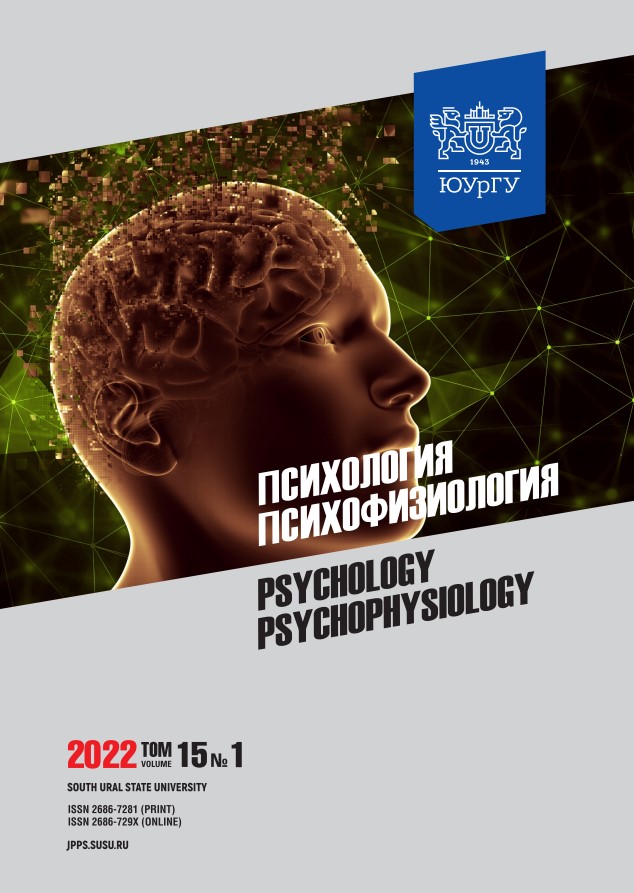Estimation of the influence of career guidance on the educational motivation of adolescents by means of correlation analysis
Abstract
Introduction. The use of correlation analysis for the study of the educational motivation of adolescents influenced by career guidance provides an understanding of insufficiently studied motivational components, that are affected the most by the formative effects of career guidance. Aim. The paper aims to identify changes in the correlation between the components of educational motivation as a result of using different career guidance technologies. The paper is based on the authors’ and T.O. Gordeeva hypothesis that educational activity should be considered as achievement-oriented. Materials and methods: the study involved 4 groups of adolescents (n=30 each group) between 14–18 years of age from the Irkutsk region. Career guidance services were provided with the help of 3 different technologies: “PROF.Navigator”,
“Digital Human”, “Proforientator” (Career guide). The following methods were used for the purpose of the study: M. Lukyanova and E. Lepeshova educational motivation, C. Dweck motivational model (as adapted by T. Gordeeva), E. Huebner multidimensional students’ life satisfaction scale (MSLSS, as translated by T. Gordeeva and N. Osina). The data obtained were processed with paired correlation analysis and the Spearman's rank correlation coefficient. Results: a strong correlation was found between the overall educational motivation of adolescents and their ability to set goals, the personal meaning of education and cognitive attitudes (prestige, the role of one’s own efforts in achieving goals, satisfaction with life). A significant positive correlation was found between achievement motivation and educational motivation and a negative one between achievement motivation and game motivation. This confirms the hypothesis that educational activity should be considered as achievement-oriented. Thus, it can be improved through a decrease in the game motivation component of educational activity. Conclusion: pairs of actively interacting motives for educational activity were identified, the correlation between which can be influenced by career guidance technologies.
Downloads
References
2. Protopopova L.F., Afanaseva A.E. Motivation and internal conflicts of high school students. Nauchnyi elektronnyi zhurnal Meridian = Scientific electronic journal Meridian. 2019;14:258–260. Available at: https://meridian-journal.ru/site/article?id=1990 (accessed 20.06.2021). (in Russ.).
3. Albrecht J.R., Karabenick S.A. Relevance for learning and motivation in education. The Journal of Experimental Education. 2018;86(1):1–10. doi: https://doi.org/10.1080/00220973.2017.1380593
4. Emeleva O.S. Development of teenagers school motivation. Vestnik Kurganskogo gosudarstvennogo universiteta. Seriya: Gumanitarnye nauki = Bulletin of Kurgan State University. Series: Humanities. 2017;1:116–118.
5. Vartanova I.I., Klimova I.V., Markina N.Yu. Motivation and responsibility of high school students when growing up. Lichnost v prostranstve i vremeni = Personality in space and time. 2017;6:43–48.
6. Gurtov V.A., Kolesnikov V.N., Pitukhina M.A. From traditional model of vocational guidance to holistic lifelong counselling: case of Finland. Nepreryvnoe obrazovanie: XXI vek = Life-long education: The 21st century. 2019;2(26):65–77. Available at: https://lll21.petrsu.ru/journal/article.php?id=4725 (accessed 20.06.2021). (in Russ., abstract in Eng.)
7. Shcherbakova E. The age limits of adolescence and youth are not rigid. Demoskop Weekly. 2012:509–510. Available at: http://www.demoscope.ru/weekly/2012/0509/barom01.php (accessed 14.05.2021). (in Russ.).
8. Gordeeva T.O., Sychev O.A., Osin E.N. Inner and outer motivation in students: its sources and influence on psychological well-being. Voprosy psikhologii. 2013;1:35a–45.
9. Kiselev P.B., Bogdanovskaya I.M. Methodology for the study of the value orientations of young people in the context of the professional spheres of the information society. Teoreticheskaya i eksperimentalnaya psikhologiya = Journal of Theoretical and Experimental Psychology. 2020;13(1):32–41.
10. Shmelev A.G., Serebryakov A.G. Psychodiagnostics in career guidance: principles of infrastructural support for computerized testing. Psikhologicheskaya diagnostika = Psychological diagnostics. 2006;2:4–16.
11. Kargin M.I., Alkanova A.S. Peculiarities of value orientations and motivation of teaching pupils of senior classes of secondary schools. Sovremennye problemy nauki i obrazovaniya = Modern problems of science and education. 2017;3. Available at: https://s.science-education.ru/ pdf/2017/3/26442.pdf (accessed 14.05.2021). (in Russ.).
References on translit
-Copyright (c) 2022 Psychology. Psychophysiology

This work is licensed under a Creative Commons Attribution-NonCommercial-NoDerivatives 4.0 International License.



